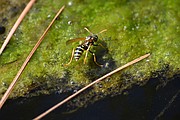Wasp, bee and hornet identification
If you’ve just been stung by a buzzing winged insect, like I was last summer, the last thing on your mind are the variations in anatomy, behavior and diet of bees, wasps, or hornets.
It seems that there are a lot of wasps, bees and hornets around this summer. Their presence is partly due to the summer heat causing fruit and flowers to ripen early. If you saw a yellow and black striped insect flying around the garden, would you know if it was a wasp, bee, or a hornet?
They look similar but they’re very different in terms of where they live, what they eat, and how likely they are to sting you.
Here’s some tips to help you tell the difference next time you spot those black and yellow stripes flying through the air.
Wasps
Wasps are carnivores and use their stingers to kill and lay their eggs inside their prey. (Before you worry … humans aren’t prey to wasps!) This means that wasps can sting more than once, but as long as you don’t disturb their nest or swat at it by flapping your arms-it generally won’t sting you.
Wasps make their nests out of small pieces of wood, which they chew to a pulp and spit out to build walls. This forms a texture similar to paper. You can spot a wasp by its bright yellow and black rings, defined waist and tapered abdomen. Only female wasps can sting!
Bees
Bees are flying insects that collect nectar pollen to make honey. They live and store their honey in complex hives made from wax, also known as honeycomb. There are many varieties of bees, so how they look differs quite a lot.
Bees are generally easy to spot because of their golden coloring and the tiny hairs all over their bodies which make them appear ‘fuzzy’. When a bee stings a human, its stinger becomes embedded in the skin, which kills the bee.
Hornets
Hornets are specific types of wasp and are usually a little rounder and fatter than common wasp. Although they nest in the same way, hornets are known to be less aggressive than wasps if unprovoked.
Hornet stings are also more painful to humans than typical wasp stings because of the chemicals found in hornet venom. Individual hornets can sting repeatedly, unlike honey bees. That’s because hornets and wasps don’t die after stinging as their stingers are not pulled out of their bodies.
An easy way to tell hornets and wasps apart is by the hornet’s brown, red and yellowish-orange marking with little black on the body. Some hornets can grow to be a whopping 2 inches in length.
Enjoy Boundary County, but watch out for the stinging winged insects!





